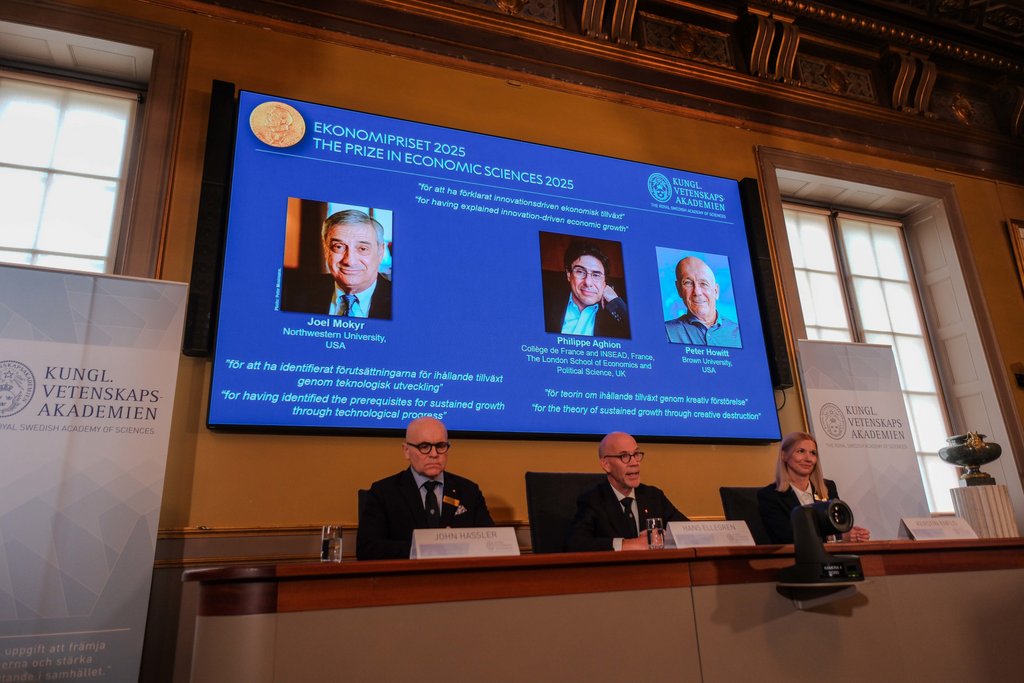Background - 14.10.2025 - 16:00
The best way to understand this prize is to travel to the past, when there was little innovation and progress. Until 1800, all human societies stagnated: children re-lived the lives of their parents, planting the same crops on the same land. “Efflorescences”—short periods of growth—did happen, but they never lasted more than a few generations before war, epidemics, and natural disasters erased all progress. Things changed around 1800, when first Britain, then Western Europe and the Americas, and finally Asia experienced for the first time sustained growth. The change was nothing short of extraordinary: a child born in 1800 could expect to live 35 years; she would have only 3 in 5 chances of celebrating her 5th birthday. Today, she can hope to see her 80s and would be all but certain to survive childhood. She can also expect to work 1600 hours a year instead that the 2700 hours her great-great-grandfather had to toil during the Industrial Revolution—one month and a half of extra vacation! And of course, she would earn much more: fourteen times more, according to some estimates. Growth over the past 200 years dwarfs everything that happened before, and the graph that depicts it is often called the “hockey-stick” line.
Capital is not the most important growth factor
How can we explain explosive growth? Capital accumulation won’t do. A plough may make a farmer two times more productive, but to double the productivity of two farmers we need two ploughs. Most inputs of production are like this: as they can’t be shared, they raise the productivity only of some workers. Most inputs, but not all: “ideas” and “technology” are different. If a farmer discovers that crop-rotation boosts harvests, nothing stops his neighbor from copying the idea. Because ideas are “infinitely re-usable” new ideas raise productivity more than capital: product per capita depends not on the number of ideas per capita, like capital: it depends on the total stock of ideas.
This year’s Nobel laureates taught us how new ideas come about. Joel Mokyr, as fine an historian as sharp an economist, looked hard at the determinants of the Industrial Revolution. His research shows that Britain’s technological rise was tightly linked to the quality of his workforce: over generations, British artisans had accumulated lots of unwritten knowledge, which allowed them to introduce and maintain ever more complex machines. In the pages of his books the Industrial Revolution takes life, and we see that “Revolution” is really a misnomer: sustained growth was the product of a “constant stream of micro-inventions,” not the result of one or two strokes of genius.
Philippe Aghion and Peter Howitt were the first to think about innovation at the firm level, asking which companies are most likely to introduce new technologies. One may expect that big, deep-pocketed companies would be the ones bringing new, disruptive technologies to the market: who else would have the resources to develop these ideas? This reasoning misses one crucial aspect of innovation, which is at the center of Aghion and Howitt work. New ideas generates both winners and losers: as they create new markets, they also “steal the business” of companies serving the old ones. This process of “creative destruction” means that technological leaders are often the least inclined to introduce new tech. Consider how the recent Artificial Intelligence “Large Language Models” revolutionized online search: since the launch of ChatGPT and similar services, people have started querying on bots instead of searching on engines. Established search engines such as Google stood to lose the most, and were reluctant to roll out the new technology. Nimbler startups like OpenAI and Perplexity instead had nothing to lose, and were quick to jump on the new idea.
The insight is profound, and it implies that innovation policy must make sure that the big players do not stifle technological progress. This year’s Nobel Prize in economics reminds us that today’s standard of living are the product of two centuries of innovation, and warns us that further progress is not automatic, but must be managed with smart innovation policies.
More articles from the same category
This could also be of interest to you
Discover our special topics
